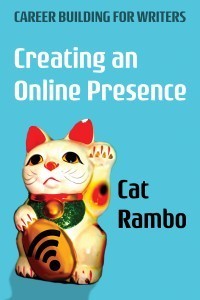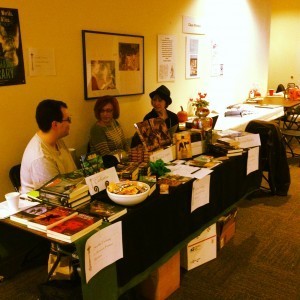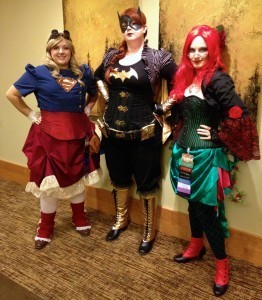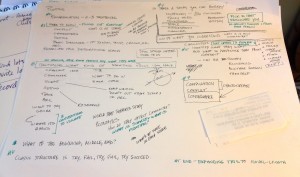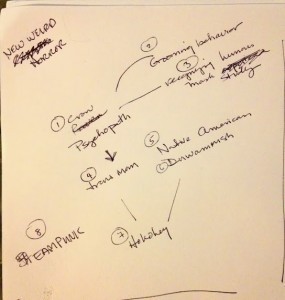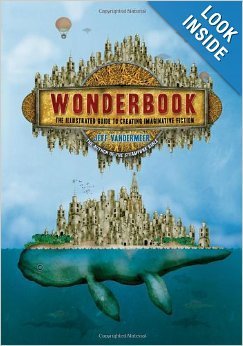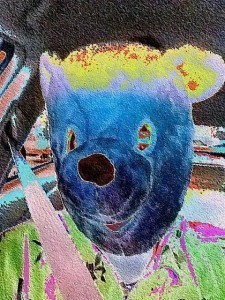Cat Rambo's Blog, page 68
December 15, 2013
2013 Wrap-Up
Here I am with a peacock's worth of color in my hair.
Well, it’s been a very good year.I had 20 original stories come out. Here’s the list, if you want to look for some of them.
DAILY SCIENCE FICTION, November, 2013. Just the Facts: A Zombie Story .
DAILY SCIENCE FICTION, October, 2013. Flying Matilda (with Gio Clairval).
DAILY SCIENCE FICTION, October, 2013. Superhero Art .
ABYSS & APEX, October, 2013. The Toad’s Jewel .
WHAT FATES IMPOSE, edited by Nayad Monroe, September, 2013. To Read the Sea.
SIGNS OF LIFE, September, 2013. Mystery in Metal.
GLITTER AND MAYHEM, edited by Lynne Thomas and Michael Damien Thomas, September, 2013. Of Selkies, Disco Balls, and Anna Plane.
EVERY DAY FICTION, August, 2013. Three Wishes .
BEYOND THE SUN, edited by Bryan Thomas Schmidt, July, 2013. Elsewhere, Within, Elsewhen.
DAILY SCIENCE FICTION, July, 2013. On the Big-Fisted Circuit .
THE MAD SCIENTIST JOURNAL, June, 2013. Prophetic Lobster Man.
CLOCKWORK PHOENIX FOUR, May, 2013. I Come From the Dark Universe.
THE JOURNAL OF UNLIKELY ENTOMOLOGY, May, 2013. Of Spiders, Centipedes and Holes.
SQ MAGAZINE, April, 2013. A Man and His Parasite.
THE OTHER HALF OF THE SKY, edited by Athena Andreadis and Kay Holt, April, 2013. Dagger and Mask.
DAILY SCIENCE FICTION, March, 2013. Soft .
GIGANOTASAURUS, March, 2013. Logic and Magic in the Time of the Boat Lifts (with Ben Burgis).
DAILY SCIENCE FICTION, February, 2013. Love’s Footsteps .
FISH, edited by Carrie Cuinn, 2013. The Fisher Queen.
EVERY DAY FICTION, January, 2013. The Passing of Grandmother’s Quilt .
My short story, “Five Ways to Fall In Love on Planet Porcelain,” appeared on the Nebula Ballot. Another first happened on that trip: got to see my charming spouse in a tux for the Nebula Banquet. The story has been reprinted into several different languages as well as in the Nebula Awards volume for 2013 edited by Kij Johnson.
I won an Ictineu Prize for the best fantasy short story translated into Catalan in 2012. The story was “Kallakak’s Cousins,” which originally appeared in Asimov’s, and was reprinted in my collection, Near + Far.
I wrote a nonfiction book, Creating an Online Presence, based on my online class of the same name. Classes overall have gone well, and I’ve even added a few more, including an advanced workshop that has been tremendous fun to teach.
I got a shiny new agent, the amazing Seth Fishman, and began shopping a novel around.
As a result of letting my blog readers determine my hair color for LoneStarCon, I’ve developed an unfortunate Manic Panic habit. I look forward to trying some additional new colors in the coming year.
I turned 50, which felt extremely weird. However, we had a rousing party for it over at the Wilde Rover in Kirkland, thanks to the party organization skills of Deanna Francis and Caren Gussoff. I felt extremely blessed to see so many of my friends in one place and realize what a great group I’m associated with.
In March, I began working with the moderating team for the SFWA private discussion boards. In some ways, it’s been a lot like working with the Armageddon MUD boards. But more cantankerous at times, which is saying a lot. Still, I was pleased to see, when looking at the logs, that traffic on those boards has literally increased tenfold. We’ve added a lot, and one effort that I’m very pleased with is the scheduled chats, which have been a lot of fun as well as very informative.
Time with my godkids is always golden. This year I accompanied them to Disneyworld in May and then got some additional time with them at Thanksgiving. Cutest, smartest, most wonderful kids in the world. 
December 12, 2013
Teaser from an Untitled Work in Progress
 This story’s still deciding whether it’s a comedy or a tragedy. I suspect a little of both.
This story’s still deciding whether it’s a comedy or a tragedy. I suspect a little of both.
When he realized how upset his wife was, George wondered if he might have miscalculated. Normally a quiet and loving partner, she was unpacking the dishwasher with a great deal of clattering and muttering.
“It’s not as though you even ever dated her!” she said, slamming a series of mugs into the cupboard.
“I don’t see what the problem is,” he replied, watching as she swept up the basket of cutlery and began throwing it into a drawer to jangle against his nerves. “I’ve left you everything. All I did was will her a copy!”
She turned, resting her hands on her hips. “You’re leaving her a copy of your personality. Essentially yourself.”
“No,” he said. “I’m leaving that to you. You’ll have me on tape, you’ll be able to transfer me into some mechanical form to keep you company. I just thought Janice might like one too.”
“Why?” Mary’s glare said she had her own suspicions.
George refused to dignify them with a reply. He’d been faithful to her all his life. A good husband. He could be allowed his own eccentricities, and If leaving a copy of himself, a digital copy created from a barrage of tests and brain scans and gathered data, to an old friend was one of those eccentricities, then he didn’t really see where Mary had the right to say much about it. She could leave her own copy or copies to her own friends.
November 19, 2013
Creating an Online Presence Now Available on Amazon!
You can find Creating an Online Presence on Amazon. The book covers the basics of creating and maintaining a presence on the Internet for writers.
Huzzah! The Kindle version of Creating an Online Presence is now available on Amazon. There will be Nook, PDF, and hard-copy version, but not until December. If you don’t have a Kindle, remember that you can download the Kindle reader for your computer or tablet.
I’m very pleased with how the book turned out. Among the things it covers: the minimum web presence a writer needs, social networks and the different approaches they require, how to find communities of readers on the Internet, how to make the most of book giveaways and listings, free tools available to help create and maintain your online presence, and how to keep all of this from swallowing up too much precious writing time.
Thank you to the many people who offered feedback and suggestions. Beta readers, you’ll be getting a special mail about this.
This is the first of the Careerbuilding for Writers series; next up is the Podcasting Basics book. I would be expecting that in January, based on how long this has taken me, but the past week has been a crash course in editing ebooks, so maybe it’ll go faster next time. 
Note: There’s still two slots open in the free session of the class this book is based on!
November 5, 2013
Northwest Book Fest: How We Did
Django Wexler, Janine Southard, and the elegantly be-hatted Louise Marley at our book table. Although we were on the 2nd floor, we had a good location, and (imo) our table was one of the nicest and most professional looking.
I’d noticed that reserving a table at the Northwest Book Fest was around 100 bucks. So I asked some other people if they would be interested in sharing a table and enough of us clubbed in that it ended up being very reasonable. We had Brenda Cooper, Louise Marley, Vicki Saunders, Jeanine Southard, Django Wexler, and myself as well as books from Hydra House, including the new Clarion West anthology, Telling Tales, and KC Ball’s short story collection.As far as selling goes, the first day was not particularly successful and on that day 50% of the book sold were to each other. The second day was more of the same, although we didn’t sell as many to each other. Overall, doing a group thing was definitely a good idea: it made for a table packed with attractive, professionally done books along with some table display stuff like a robot, a war-elephant, and some fantasy stuffed animals (including plushie Chtulhu). It also meant we had people to chat with and the livelier appearance of our table helped pull people in, I think. (Plus we had candy.) We might have done better on the first floor than the second, and there were some lighting issues.
I presented a workshop on podcasting, which was well attended, and I ran them through some whys and whats of recording your own podcast as well as ranting a bit about rights and not paying to publish. A number of them signed up to get advance notice of the Building an Online Presence for Writers book.
Overall, it was fun, and there was some decent networking, plus I passed out some postcards on my classes. On the other hand, did we sell many books? Not at all. However, the cost of the $100 table, split between all of us, was pretty darn reasonable, and it meant we could attend workshops. We didn’t have a formal name, so I’d put “Seattle Speculative Fiction Writers” down. So many people asked about our group the first day that Django ended up putting out a sign-up sheet for news of group activities and gathering two pages of e-mail addresses. I look forward to the first wine and chat party.
If I ran an effort like this again, I’d focus more on selling: perhaps do book bundles, make a sign letting people know the books were priced at special rates for the book festival, maybe have some lower-priced items or stocking-stuffer type trinkets, and would have a signup sheet for other mailing lists, like each author’s. However, the location was so difficult to get to that there was no foot traffic and some people had difficulty finding the place — if they do it in the same location next year, I’ll pass and spend that time writing instead, but as Brenda noted, if they move it back downtown, it might be worthwhile.
October 30, 2013
Convention Report: SteamCon 2013
One of the joys of SteamCon is the wealth of costumes. These lovely ladies were at my last panel, the one on cryptozoological expeditions. Supposedly there was a steampunk Wonder Woman there too, but I never spotted her.
Lisa Mantchev described it best when she Tweeted: I’ve never actually been run over by a Zamboni full of glitter, but that’s what it feels like after a really great convention.That’s how SteamCon was. I arrived Friday afternoon for the Steampunk Reimagines Fairy Tales. This was a writing-focused panel, and I’d like to see future SteamCons make a wider space for a writing track, since this was jam-packed with attendees. Lisa Mantchev was our excellent moderator, and J.R. Boyett, a fellow participant in the FairyPunk project, was another panelist. We talked about how to create stories that best take advantage of the steampunk setting, without making it seem as though you’re just gluing a gear on it.
Later that evening, I had the first of my three panels on Victorian explorers. This was the best of them, because it focused on women explorers, and that’s an area I am reasonably well-read in, because I love some of those stories so much. That session included moderator Carmen Beaudry, Lori Edwards and another exquisitely garbed woman whose name, unfortunately, I didn’t catch. It was AWESOME and we all had a lovely time. I’ll mention some of the names we touched on, and urge you to go look these ladies and their amazing stories up: Harriet Chalmers Adams, Gertrude Bell, Isabelle Eberhardt, Mary Kingsley, Annie Smith Peck, May French Sheldon, and Lady Hester Stanhope, among many others.
Saturday was two more panels on expeditions, first one with Joshua Merrill-Nach on Great Quests of the 19th Century and later one on cryptozooological expeditions with a last minute substitute panelist whose name I know only as “Sean,” unfortunately, but who was terrific. Both panels were pretty full, the second one standing room only.
Sunday morning, I read from “Her Windowed Eyes, Her Chambered Heart” to a small but select audience that included the fabulous Sandra M. Odell. And then I made one last pass through the wonders of the dealer’s room and retreated home. Adieu glitter and goggles!
October 25, 2013
Free on the Kindle for Two Days: Eyes Like Sky and Coal and Moonlight
I’m running an Amazon giveaway today and tomorrow – Eyes like Sky and Coal and Moonlight is free to download. Please check it out if you haven’t, and if you like it, I hope you’ll leave a review!
October 22, 2013
About Writing: Coaxing a Seed into a Story
This is a photograph of one sheet of notes from planning the class. Often stories are planned this way as well. I'll jot down what I know so far about it and begin using that information to generate other pieces, such as character wants and the sources of conflict.
Last night we had the final session of the Writing Fantasy and Science Fiction class, which is the session where we talk about everything except writing: stuff like going to conventions, and how to submit stories, and how to treat editors and what about audio markets and all that sort of thing. And I’d meant to include a section about plotting stories, because I’d taught a new class the day before, the Moving Your Story From Idea to Finished Draft class, and as often happens had come up with some new things to say about stories from thinking about one specific aspect, but there just wasn’t enough time. So I want to talk a little bit about it in a blog post.As always, everyone’s writing process is different and the only one I can speak with authority about is my own. So perhaps this will click for you and perhaps it won’t. I hope it does.
Certainly, there are stories that arrive complete. They appear in my head and all I have to do is write them down. This is most likely to occur during the night, meaning I can rise, go to the keyboard, and bang it all out quickly. For example, “Pippa’s Smiles” arrived complete and ready to go, though it had its roots in some thoughts I had been mulling over about gendered narratives. Unfortunately, though, that’s not usually how it works.
For me, stories can start in a number of ways.
They can start as a concept or idea: What if ghosts could fly into your mouth when you yawn? What if people could go back and live their lives over and over? What if some people could acquire psychic powers?
A story can start with a particular character. That may be someone glimpsed on the street, or a historical figure that I find interesting and want to write about. Victoria Woodhull is a American from the 19th century who I have used more than once as a character.
It can start with a particular scene that emerges vividly in my head. I may not know who the characters are, or why they’re there, but I know what it looks like.
It may start with a particular theme. A recent story, “Elsewhere, Within, Elsewhen,”started with me thinking about how people accumulate layers of grudges. I decided that I wanted to literalize that metaphor and the story came quickly when I began exploring that idea.
I have on occasion decided that I want to work in a genre that I have not tried before. That’s as valid a place to start a story as any. If I’m doing that, I often try to figure out the genre conventions and decide which I want to violate. A recent piece I finished, for example, is one where I decided I wanted to try writing a piece of horror fiction that drew heavily on very visceral, physical details.
Often my starting point is another story by someone else. Many of my stories are replies to other pieces that have influenced me: Hemingway’s The Old Man and the Sea; Robert Heinlein’s “The Menace From Earth”; O. Henry’s “The Pimaloosa Pancakes”; and Hans Christian Andersen’s “The Little Mermaid”, among others.
A story can also start with a piece of research. I used to write encyclopedia articles and when I ran across the story of Jumbo the elephant being purchased by PT Barnum, I knew I had to write something about it, because the details were just so fabulous and Jumbo’s eventual fate so moving. That ended up becoming “The Towering Monarch of His Race.”
A story may begin as a deliberate attempt to break a rule or guideline. I wrote “Whose Face This Is, I Do Not Know” as a reaction to one of my Clarion West classmates saying how much he hated stories where the author has a character look in a mirror in order to describe what the character looks like. I started thinking about a story in which the main character had to keep checking their appearance, because it was constantly changing.
A story may even start with a particular title. That’s how “I’ll Gnaw Your Bones, the Manticore Said” came about. All I knew about it was that there was a manticore somewhere in the story.
Those are all perfectly valid ways to start stories, at least for me, and I’ve used all of them at least once. The question that we explored in the class is what to do with each of those in order to start figuring out the story. One way is always to just sit down and start writing, doing what Samuel R. Delany calls “writing to discover.” Sometimes that works well. Other times it may not. My trick is to usually try to figure out the characters, if I don’t have them, and particularly the main character. The most important thing to discover about that main character is what they want, because that drives their actions and helps you figure out how the story will move along.
Knowing the character and what they want helps you discover how they are being prevented from getting what they want. Once you’ve got that, you’ve got some conflict that will help drive things along.
Part of what to do next depends on your own individual process. If you are someone who cannot write the story until they know everything that will happen, then you need to figure that out, while another person may just need a initial few facts in order to sit down and start writing in order to figure out what’s going on. Personally, I would begin thinking in terms of scenes. Get a list of those together and don’t worry about the order for now. You can always rearrange them once they’re written. This is one reason why increasingly I have been drafting stories in Scrivener; that software makes it very easy to move scenes around.
How does your process differ? Have I overlooked any possible ways stories can start?
October 21, 2013
WIP Teaser: Her Windowed Eyes, Her Chambered Heart
Example from a different story showing the first notes made when plotting out "Rappacini's Crow." Not every detail here got used, but the notes helped me keep fleshing out the idea until I was ready to write it.
Here’s a snippet from what I’ve been working on today. Peeps who attended the Plotting class yesterday (which was AWESOME) – this is the steampunk horror story that I showed you the initial notes for.A frenzy of fretwork adorned the house’s facade, but it was splintery, paint peeling in long shaggy spirals that fuzzed the puzzled outlines. The left side drooped like the face of a stroke victim, windows staring blindly out, cataracted with the dusty remnants of curtains.
Marshall Artemus Smith thought that it would have given a human man the chills. He glanced back at Elspeth to see how she was taking, but her face was chiseled and resolute as a fireman’s axe.
“You all right?”
She swabbed at her forehead with a bare forearm, leaving streaks of dark wet dirt. “Thank your lucky stars you don’t feel the heat,” she rasped.
Hot indeed if enough to irritate her into mentioning that. He chose to ignore it.
The house sagged amid slumping cottonwoods, clusters of low-lying groves, their leaves indifferent ovals of green and pale brown. Three stories, and above that, two cupolas thrust upward into the sky, imploring, the left one tilted at an angle.
His spurs jingled as he clanked up the front steps. His eyes ratcheted over the scene for clues, but it was clear that their fugitive had entered by the front door, which hung a few inches ajar.
Wood creaked under Elspeth’s slower treads. “This was his mother’s house,” she said.
She’d gone over the files meticulously as always, then summed up the details for him as they’d ridden along. He ticked through them in his head.
“The scientist?”
“Angeline Pinkney, yes. She helped discover how to harness phlogiston. They had her working on the war effort till she was dying of rotlung. Then she retired out here and lasted another two years.”
Phlogiston, the most precious material in the world, capable of fueling marvelous machines like himself. He carried a scraping of it, small as a fingernail clipping, deep in his midsection. Once a year, it was replaced, but it was valuable enough that he’d had people try to kill him for it before.
So far none had succeeded.
October 18, 2013
Jeff VanderMeer’s Wonderbook: The Illustrated Guide to Creating Imaginative Fiction
It's a gorgeous book, and I've skimmed through some tasty tantalizations in it so far.
I’ve been following Jeff’s posts about this book, which is a very VanderMeerian approach to writing theory, for a while, and so I danced around a bit when this arrived in yesterday’s mail.If you haven’t heard of it, here is the description from the Amazon listing:
This all-new definitive guide to writing imaginative fiction takes a completely novel approach and fully exploits the visual nature of fantasy through original drawings, maps, renderings, and exercises to create a spectacularly beautiful and inspiring object. Employing an accessible, example-rich approach, Wonderbook energizes and motivates while also providing practical, nuts-and-bolts information needed to improve as a writer. Aimed at aspiring and intermediate-level writers, Wonderbook includes helpful sidebars and essays from some of the biggest names in fantasy today, such as George R. R. Martin, Lev Grossman, Neil Gaiman, Michael Moorcock, Catherynne M. Valente, and Karen Joy Fowler, to name a few.
It’s a freaking GORGEOUS book (to the point where I’m surprised by the relatively low price, given how glossy it is). I spent some of last night flipping through and being delighted. I’m looking forward to a more careful read. Highly recommended.
October 17, 2013
Sign Up Now For a Free Session of Building an Online Presence for Writers
Do we really have to resort to cheap tricks like bear masks, invoking bacon, or animated gifs to create our presence on the Internet? Find out the answer in a free session of Building an Online Presence for Writers, Friday, December 6, 2013, 10-11 AM PST.
On Friday, December 6, at 10 AM PST, I’ll be running a special one hour session of the Building an Online Presence for Writers class that will be broadcast on G+ as well. It’s free, but you do need to sign up beforehand since it’s limited to eight people. Attendees will also get a copy of the e-book, Building an Online Presence for Writers.What will the class cover? Primarily I’ll let the questions of the participants drive this session, but here’s some basics covered inthe two-hour version and the book:
Before you start: Figuring out what you want to accomplish and how to measure it; compiling a mailing list; how to set up your online presence in order to best protect your privacy.
Setting up your website: What do you need to have? What’s the best way to host it?
Blogging: Do you need to blog? What’s the most effective way to do it without putting too much precious writing time into it? What do you write about? How often do you need to blog? What are some alternatives to blogging?
Social networks, such as Facebook, G+ and Twitter: Are there any you must participate in? What are the best practices? How do you avoid them becoming a terrible timesink? What are there beside the big 3 and what are the differences? What tools can you use for handling them?
How should you take advantage of social bookmarking sites, crowdfunding, reader communities, podcasting, SEO, Google Analytics, and mobile devices?
The class is limited to eight participants. Mail me at catrambo AT gmail.com to sign up.
On a related note, there are two slots left in the next Advanced Workshop, which runs Saturday mornings 9:30-11:30 AM December 7, 14, 21 and January 4, 11, 18. I announced it two days ago on the mailing list; if you want to make sure you get first notice of classes and special offerings, sign up for the mailing list:
#mc_embed_signup{background:#fff; clear:left; font:14px Helvetica,Arial,sans-serif; }
/* Add your own MailChimp form style overrides in your site stylesheet or in this style block.
We recommend moving this block and the preceding CSS link to the HEAD of your HTML file. */
Subscribe to the class mailing list
* indicates required
Email Address *
First Name
Last Name
Email Format
html
text
mobile
var err_style = '';
try{
err_style = mc_custom_error_style;
} catch(e){
err_style = '#mc_embed_signup input.mce_inline_error{border-color:#6B0505;} #mc_embed_signup div.mce_inline_error{margin: 0 0 1em 0; padding: 5px 10px; background-color:#6B0505; font-weight: bold; z-index: 1; color:#fff;}';
}
var head= document.getElementsByTagName('head')[0];
var style= document.createElement('style');
style.type= 'text/css';
if (style.styleSheet) {
style.styleSheet.cssText = err_style;
} else {
style.appendChild(document.createTextNode(err_style));
}
head.appendChild(style);
setTimeout('mce_preload_check();', 250);
var mce_preload_checks = 0;
function mce_preload_check(){
if (mce_preload_checks>40) return;
mce_preload_checks++;
try {
var jqueryLoaded=jQuery;
} catch(err) {
setTimeout('mce_preload_check();', 250);
return;
}
var script = document.createElement('script');
script.type = 'text/javascript';
script.src = 'http://downloads.mailchimp.com/js/jqu...
head.appendChild(script);
try {
var validatorLoaded=jQuery("#fake-form").validate({});
} catch(err) {
setTimeout('mce_preload_check();', 250);
return;
}
mce_init_form();
}
function mce_init_form(){
jQuery(document).ready( function($) {
var options = { errorClass: 'mce_inline_error', errorElement: 'div', onkeyup: function(){}, onfocusout:function(){}, onblur:function(){} };
var mce_validator = $("#mc-embedded-subscribe-form").validate(options);
$("#mc-embedded-subscribe-form").unbind('submit');//remove the validator so we can get into beforeSubmit on the ajaxform, which then calls the validator
options = { url: 'http://kittywumpus.us6.list-manage.co...?', type: 'GET', dataType: 'json', contentType: "application/json; charset=utf-8",
beforeSubmit: function(){
$('#mce_tmp_error_msg').remove();
$('.datefield','#mc_embed_signup').each(
function(){
var txt = 'filled';
var fields = new Array();
var i = 0;
$(':text', this).each(
function(){
fields[i] = this;
i++;
});
$(':hidden', this).each(
function(){
var bday = false;
if (fields.length == 2){
bday = true;
fields[2] = {'value':1970};//trick birthdays into having years
}
if ( fields[0].value=='MM' && fields[1].value=='DD' && (fields[2].value=='YYYY' || (bday && fields[2].value==1970) ) ){
this.value = '';
} else if ( fields[0].value=='' && fields[1].value=='' && (fields[2].value=='' || (bday && fields[2].value==1970) ) ){
this.value = '';
} else {
if (/\[day\]/.test(fields[0].name)){
this.value = fields[1].value+'/'+fields[0].value+'/'+fields[2].value;
} else {
this.value = fields[0].value+'/'+fields[1].value+'/'+fields[2].value;
}
}
});
});
$('.phonefield-us','#mc_embed_signup').each(
function(){
var fields = new Array();
var i = 0;
$(':text', this).each(
function(){
fields[i] = this;
i++;
});
$(':hidden', this).each(
function(){
if ( fields[0].value.length != 3 || fields[1].value.length!=3 || fields[2].value.length!=4 ){
this.value = '';
} else {
this.value = 'filled';
}
});
});
return mce_validator.form();
},
success: mce_success_cb
};
$('#mc-embedded-subscribe-form').ajaxForm(options);
});
}
function mce_success_cb(resp){
$('#mce-success-response').hide();
$('#mce-error-response').hide();
if (resp.result=="success"){
$('#mce-'+resp.result+'-response').show();
$('#mce-'+resp.result+'-response').html(resp.msg);
$('#mc-embedded-subscribe-form').each(function(){
this.reset();
});
} else {
var index = -1;
var msg;
try {
var parts = resp.msg.split(' - ',2);
if (parts[1]==undefined){
msg = resp.msg;
} else {
i = parseInt(parts[0]);
if (i.toString() == parts[0]){
index = parts[0];
msg = parts[1];
} else {
index = -1;
msg = resp.msg;
}
}
} catch(e){
index = -1;
msg = resp.msg;
}
try{
if (index== -1){
$('#mce-'+resp.result+'-response').show();
$('#mce-'+resp.result+'-response').html(msg);
} else {
err_id = 'mce_tmp_error_msg';
html = '
'+msg+'
';
var input_id = '#mc_embed_signup';
var f = $(input_id);
if (ftypes[index]=='address'){
input_id = '#mce-'+fnames[index]+'-addr1';
f = $(input_id).parent().parent().get(0);
} else if (ftypes[index]=='date'){
input_id = '#mce-'+fnames[index]+'-month';
f = $(input_id).parent().parent().get(0);
} else {
input_id = '#mce-'+fnames[index];
f = $().parent(input_id).get(0);
}
if (f){
$(f).append(html);
$(input_id).focus();
} else {
$('#mce-'+resp.result+'-response').show();
$('#mce-'+resp.result+'-response').html(msg);
}
}
} catch(e){
$('#mce-'+resp.result+'-response').show();
$('#mce-'+resp.result+'-response').html(msg);
}
}
}


